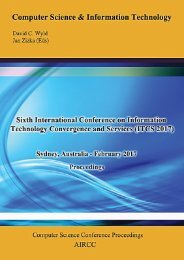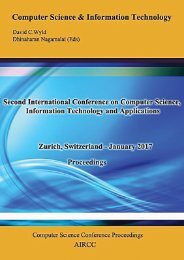CoSIT 2017
Fourth International Conference on Computer Science and Information Technology ( CoSIT 2017 ), Geneva, Switzerland - March 2017
Fourth International Conference on Computer Science and Information Technology ( CoSIT 2017 ), Geneva, Switzerland - March 2017
Create successful ePaper yourself
Turn your PDF publications into a flip-book with our unique Google optimized e-Paper software.
160 Computer Science & Information Technology (CS & IT)<br />
The last two parts of the figure show Item 3 (Legal Proceedings) and Item 7 (Management´s Discussion<br />
and Analysis of Financial Condition and Results of Operations) contained in the 10-K section of the<br />
“Complete Submission Text File”<br />
6. VALIDATION OF EXTRACTION ALGORITHMS<br />
In order to validate the proposed extraction algorithms and to test their capabilities, I retrieve all Form<br />
10-K filings listed in the SEC EDGAR form index files. Using the data gathering method as described<br />
in Section 3 in total 188,875 annual reports (167,599 on Form 10-K and 21,276 on Form 10-K405 )<br />
filed between 1993 and 2016 are retrieved from the EDGAR database (SEC EDGAR Form 10-K types<br />
as used in Loughran and McDonald 2011a). The “Annual Report Algorithm” is applied to all<br />
submissions to derive different word counts for each filing made with the SEC. In addition to the<br />
overall word count of an annual report, for each core document (10-K section) and the exhibits<br />
embedded in a “Complete Submission Text File” an individual word count is retrieved in order to be<br />
compared (XBRL files declared as exhibits are deleted). Figure 3 illustrates how word counts for each<br />
filing and its components are obtained from the “Complete Submission Text File” for the document<br />
validation process of the “Annual Report Algorithm”.<br />
Figure 3. Document validation process of the “Annual Report Algorithm”.<br />
Notes: The figure presents the document validation process of the “Annual Report Algorithm”. The<br />
“Complete Submission Text File” of each financial statement as provided on the SEC server is used to<br />
extract all relevant components (documents). The “Annual Report Algorithm” is applied to each filing in<br />
order to retrieve word counts for all relevant documents embedded in the submission. The word count of all<br />
relevant documents is compared with the overall length of the submission. A mismatch between the word<br />
counts would indicate that the entire report contains nonrelevant document (file) types after applying the<br />
“Annual Report Algorithm”.<br />
This word count comparison between the overall report on full length and its different components<br />
cannot be a validation of the “Annual Report Algorithm” since the same algorithm is simply applied<br />
to different sets of textual information (10-K section, exhibits, full report). However, if the entire<br />
report would still contain document (file) types or elements which are not a part of the core 10-K<br />
section or a corresponding exhibit the word count of a certain financial statement would be artificially<br />
increased (Word Count Full Report). In fact, the ability to validate the entire extraction procedure by<br />
applying an alternative to the “Annual Report Algorithm” (e.g. HTML-Parser) is limited since to a<br />
certain extent the same regular expressions have to be used to create the input for both extraction<br />
methods in the first place (extracting core 10-K document and exhibits, deleting nonrelevant<br />
document (file) types etc.). Due to this disability in validating the entire extraction process from the<br />
beginning by applying an HTML-Parser one has to validate the input the proposed algorithm is<br />
creating and its extraction results separately, therefore validating the entire information extraction<br />
process. The validation of the textual input created by the “Annual Report Algorithm” is represented<br />
by the extraction algorithm itself since it uses only regular expressions combined with the electronic<br />
filing requirements introduced by the SEC (precisely not the SEC but Attain, LLC). According to the<br />
SEC, all documents embedded in a “Complete Submission Text File” must be equipped with a





